Living in the vertical landscape that is New York City, riding in elevators is a familiar, even mundane activity. Ascending and descending, we arrive to our apartments, offices, the library, and even grocery stores. Still, after a quick trip to the eighth floor of a nondescript, corporate office space, it is a rare and even surprising treat to encounter the engaging and eclectic art exhibition, Between History and the Body, now on view in the aptly named gallery The 8th Floor.
Though unknown to many of the passersby along 17th Street, The 8th Floor celebrates its fifth anniversary this year, having been founded in 2010 by the collector/philanthropist couple Shelley and Donald Rubin. Previously, contemporary Cuban art dominated The 8th Floor’s exhibition schedule, reflecting one aspect of the Rubins’ collecting interests.[1] However earlier this year the gallery broadened its geographical focus, ambitiously revising its mission, “to explore the potential of art as an instrument for social change in the 21st century.”[2]
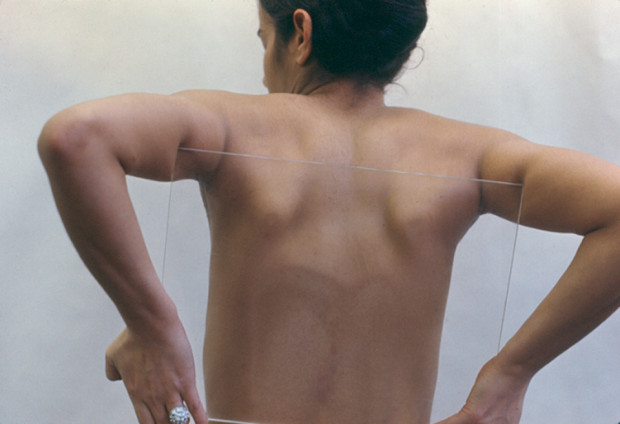
Suite of six estate color photographs
16 x 20 inches each
Edition 7 of 10
Courtesy of the Estate of Ana Mendieta and Galerie Lelong
Such lofty goals are reflected in the current show Between History and the Body. Curated by Sara Reisman, artistic director of The Shelley and Donald Rubin Foundation and the former director of New York City’s Percent for Art Program, the exhibition positions itself as, “a discursive territory in which ideas surrounding the construction of identity converge.”[3] Although the works on view are perhaps less praxis-oriented than is suggested by either this claim or the gallery’s mission, the show nonetheless raises and contests historical and societal paradigms regarding race, culture, gender, and sexual orientation. Focusing on representations of the body as a site of identity, an agent of protest, and a symbol of projected myths, Between History and the Body features an intriguing range of photographs, drawings, collages, sculptures, and videos by a diverse group of twelve artists, many of whom work locally in New York.
Inconspicuously tucked into a corner of the gallery, Ana Mendieta’s 1972 series of untitled photographs provides a suitable entry to Between History and the Body. The series is somewhat of an outlier as both the oldest and only piece by a deceased artist featured in the show. Perhaps included as a nod to The 8th Floor’s previous focus on Cuban art, the photographs portray Mendieta pressing her naked body against a transparent pane of glass, squeezing, separating, and smashing her breasts, buttocks, and stomach. Mendieta’s contorting gestures seem to beg the meaning of so much flesh. How can we manipulate/be manipulated by our bodies, and what does this pliable material ultimately signify? Indeed, the presence/absence of the body is particularly significant to the much-mythologized career of Mendieta.
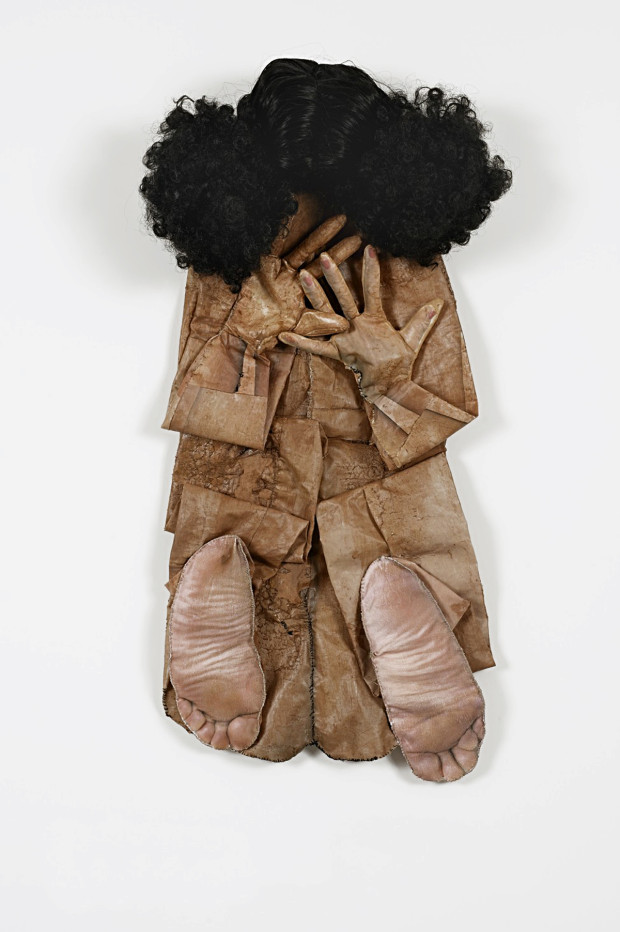
32 x 15 x 6 inches
Courtesy of the artist
An early example of Mendieta’s performance based practice, the presentation of this untitled series at The 8th Floor offers a somewhat rare and refreshing opportunity to view a work that is not from the artist’s more ubiquitous Silueta series. Consisting of six individual photographs, Mendieta’s untitled piece shares a narrative quality with a number of other works in the show, including Haitian-born Jean-Ulrick Désert’s The Passion (2006). Inspired by the frenzied love of soccer fans, Désert’s 46 print work bridges photography with performance. For the piece the artist created fantastical all-white costumes for his sitters, who he then photographed singly and in groups. Recalling traditional studio portraiture, the resulting images sublimate the individual identities of these fans/fanatics into their shared passion, which acquires a menacing, cult-like aura. Clothed head to toe in white, Désert’s figures create an unambiguous visual association to the infamous hooded costumes of the Ku Klux Klan.
Charcoal drawings by Queens-based artist Shaun Leonardo similarly bring forth contemporary issues of race and racism, particularly in two timely sets of drawings based on the deaths of Michael Brown and Eric Garner (2015). For these works, Leonardo adopts a cartoon-panel presentation, depicting the sites where the two men were killed. Rather than focusing on the actual events that transpired, Leonardo’s drawings center on the locations where the events took place, documenting the ebb and flow of police, reporters and onlookers in the days following Garner and Brown’s deaths. Notably, Between History and the Body features additional drawings by Leonardo, including a self-portrait that illustrates the artist as a wrestler in a match. Alluding to the performance-based side of Leonardo’s artistic practice, this drawing depicts the artist’s torment at the hands of his opponent, whose body is presented as a white void. In the drawing, Leonardo’s neck is being twisted by this invisible adversary, linking the artist to Eric Garner and thereby questioning the fate of black men in contemporary society.
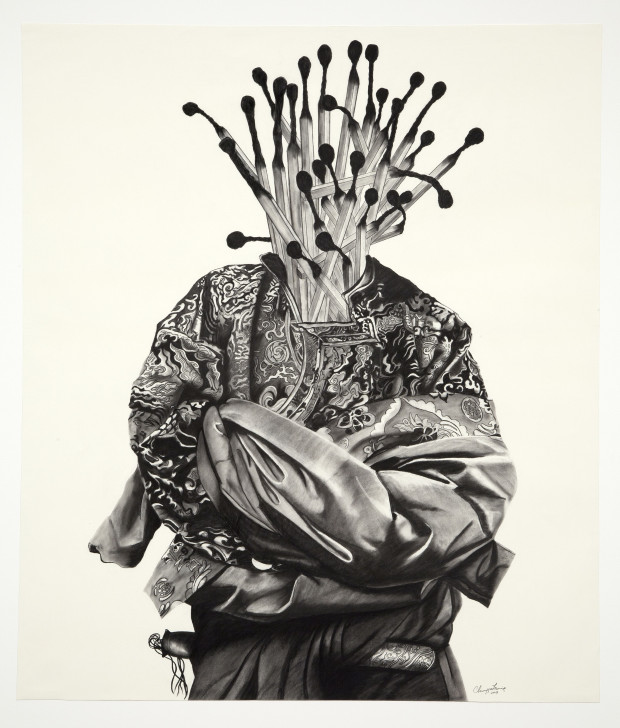
Charcoal on paper
42 x 36 inches
Courtesy of the Shelley and Donald Rubin Private Collection
Like Leonardo, Tibetan artist Chungpo Tsering works in charcoal on paper to create his near-life-size three-quarter length portraits of humanoid hybrids. In the three works on view at The 8th Floor, Tsering substitutes the heads of his otherwise realistically rendered figures for such incongruous items as a bouquet of flowers (Untitled), a hoard of used matches (When the Air is Thin) and a cluster of surveillance cameras (Selfie) (all 2014). Masterfully executed, the resulting witty yet monstrous figures are ripe with allusions to popular culture, religion, and historical traditions embedded (in this case to a disturbingly literal degree) within each of our identities.
Chungpo Tsering’s combinatory tactic is taken up by a number of other artists in Between History and the Body who also utilize collage, assemblage, and layering in their practice. For her Portrait of a Young Girl, New York-based artist Elia Alba transferred photographs of various skin tones and body parts onto fabric, creating a body suit/sculpture/surrogate, whose head is crowned with a mop of curly, synthetic hair. Folded in on itself like a body without bones, Portrait of a Young Girl reads like the skin of a shedding snake or, more grotesquely, like a human body smashed in a horrific accident. Mounted on a column in the gallery, the figure in Portrait of a Young Girl clasps its hands over its face as if ashamed or unable to confront its patchwork beauty.
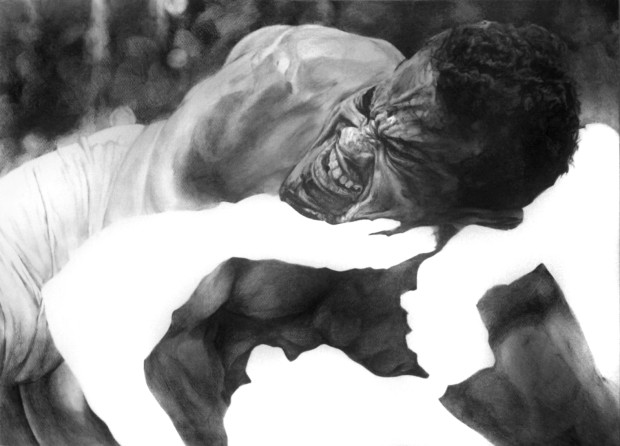
Courtesy of the artist
Alba’s Portrait of a Young Girl comes to life in the video If I were A…, in which male performance artist Nicolás Dumit Estévez dons three of Alba’s female-gendered suits. However, in contrast to the brilliant display of Portrait of a Young Girl, the placement of If I were A… in the elevator entryway makes for an awkward presentation. Fortunately, videos featuring the Dominican born Estévez are shown elsewhere in the gallery where they make for delightfully perverse viewing. In USA Paradisiaca (2001), stereotypes about gender and Caribbean identity are playfully skewered in a series of cooking demonstrations centering on the phallic plantain. The video is shot in a comically low-brow quality and periodically cuts to gender-bending images of nails, painted Pepto-Bismol pink, piercing the fruit or a stubbled, lipsticked mouth consuming the victuals. Estévez’s erotically charged Tongue Training (2001) also focuses on the humorous and sensual potential of the mouth, documenting the artist as he maneuvers his tongue to the beat of a vintage soundtrack, following the commands of a voice from offstage.
Though Estévez’s sexually-charged videos addresses much different issues than Alba’s Portrait of a Young Girl or If I were A…, the collaboration between these two artists provides an example of the connections and dialogues that extend throughout the works on view at The 8th Floor. Indeed, in some respects, the subject matter of Between History and the Body treads well-worn territory, however the assembled works together create a dynamic and compelling exhibition. While it remains to be seen whether the gallery is able to achieve its newly revised mission, Between History and the Body and the events organized in conjunction with the show invite repeat rides up to The 8th Floor.
Between History and the Body is open at The 8th Floor (17 West 17th Street) through October 16. Additionally, the following events will be open to the public:
Friday, September 11, 2015, 6:00 to 8:00pm
Brendan Fernandes, Nicolás Dumit Estévez, and Saya Woolfalk in conversation with Sara Reisman
Friday, September 18, 6:00 to 8:00pm
Jeffrey Gibson, Firelei Báez, and Jean-Ulrick Désert in conversation with Sara Reisman
Wednesday, October 7, 6:00 to 8:00pm
Performance by Shaun Leonardo
For more information, please visit http://the8thfloor.org
[1] Another being Himalayan and Southeast Asian art, as displayed at the nearby Rubin Museum of Art.
[2] “About,” The 8th Floor Gallery, http://the8thfloor.org/#home, accessed September 5, 2015.
[3] Sara Reisman, “Between History and the Body,” The 8th Floor, exhibition brochure (July 9-October 16, 2015).

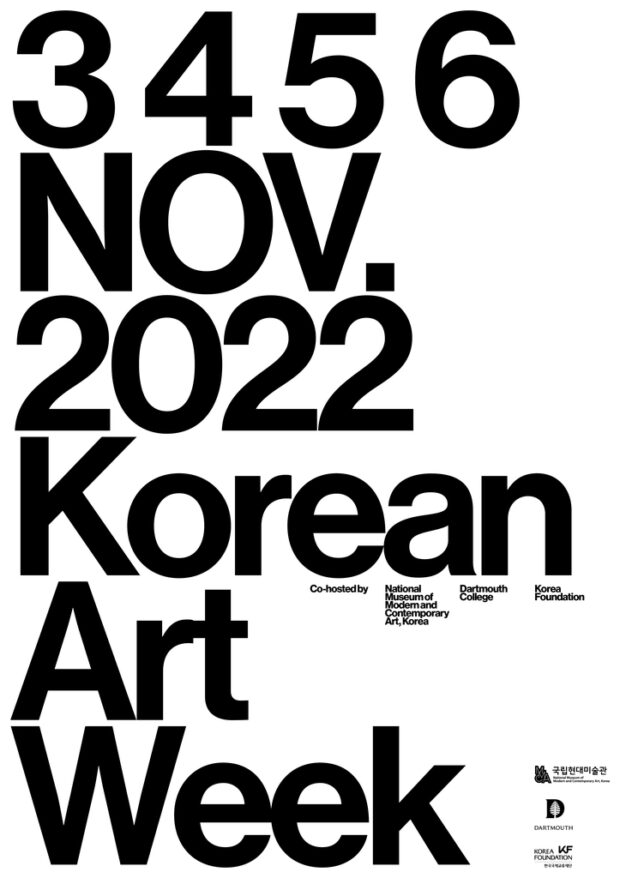


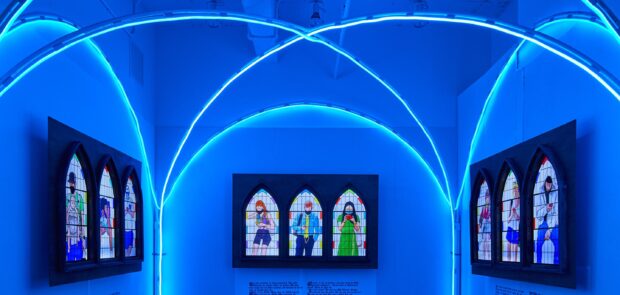

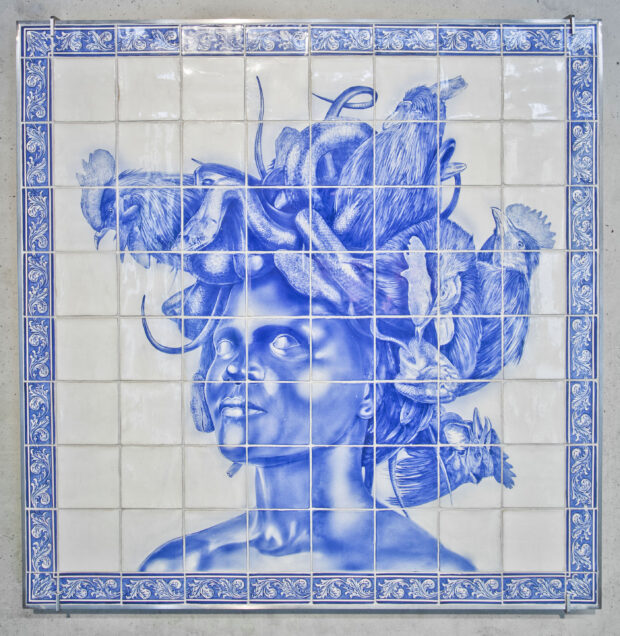


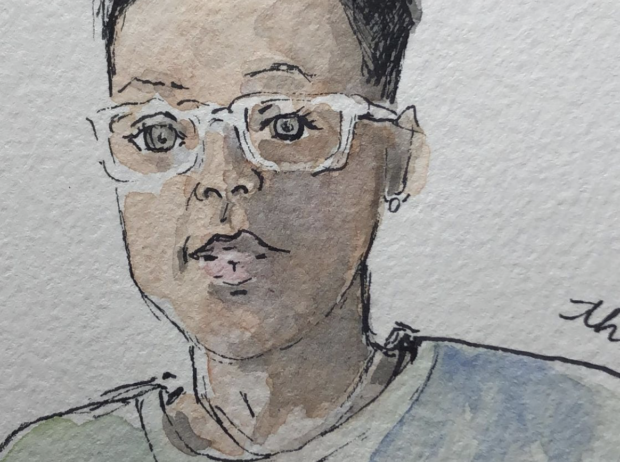
Be First to Comment